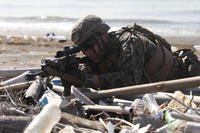On the heels of a 12-year deployment to Japan, the Navy's amphibious assault ship Essex (LHD 2) is now at Navy homeport San Diego amidst a historic 18-month, $150 million maintenance and upgrade, service officials said.
Work on the Essex includes both standard maintenance as well as key upgrades and modernization efforts, said Capt. Joker Jenkins, commanding officer of the USS Essex.
"This is the largest non-carrier upgrade in the history of the surface Navy. The Navy is buying warfighting readiness for the next twenty years," Jenkins said.
Work on the Essex is a success for the Navy in light of ongoing concerns that the current sequester could delay needed maintenance on ships, service officials said.
However, in light of Congress' recent move at the end of March to pass a Defense Department appropriations bill, the expected budget shortfall is not as dire as was initially thought, a service official explained.
At one point, the service was planning to delay or cancel planned maintenance on as many as 23 ships, a circumstance that was averted by passing the appropriations bill. The military will no longer need to operate under a continuing resolution that maintained funding at 2012 levels and kept leaders from moving needed funds into the Operations and Maintenance budget.
"With the appropriations bill, we no longer have a $4.6 billion shortfall," a Navy official said.
However, due to sequestration, the Navy is still looking at about a $4 billion shortfall in their Operations and Maintenance account for fiscal year 2013. Commanders are currently making evaluations regarding which maintenance may or may not still need to be delayed, the Navy official added.
"Commanders are currently making those decisions and we may be able to restore a certain level of readiness and depot level maintenance," a service official said.
Part of the work, taking place on a dry dock at Naval Base San Diego, includes maintenance on the ballast tanks, hull and flight deck as well as efforts to equip the ship with the latest fuel consumption technology, electronics, software, computing and communications equipment, Jenkins said.
Much of the modernization work being done on the USS Essex is work which can only be done in the U.S., and therefore could not happen while the ship was deployed in Japan.
Navy officials expect to finish the maintenance and modernization effort by Spring 2014. The work will include upgrading the electronics and software for the ship's weapons systems as well as improving the communication or "networking" infrastructure.
The technological work on theEssex is quite expansive, including the addition of new networks, servers, and more efficient routers..
"Warfare commanders are always wanting richer imagery and more data. We're getting wireless technology installed in the command spaces so you can more easily view a computer brief. This gives us more efficient and better ways of passing information," Jenkins said.
In fact, part of the electronics upgrades to the ship includes the addition of digital controls for the boilers, which both increase fuel efficiency and also lessens the man-hours needed to run the engines, Jenkins said.
He explained that an electronic fuel consumption system reduces needed manpower by 80-percent.
"The digital controls for the boilers automatically measure based on demand, and can change the combustion ratio. We can operate more efficiently and burn less fossil fuels over the course of a deployment," Jenkins said.
The boilers boil water and turn it into steam, sending thermal energy to main engine turbines, driving the shafts and making the ship go through water, Jenkins explained. The steam turbines also generate electricity for the ship, powering everything from weapons systems to radar, electronics and communications systems, Jenkins said.
The maintenance work includes important restoration of the ship's hull and ballast tanks so that the salt water damage can be repaired.
"These ballast tanks allows the AAVs (Amphibious Assault Vehicles) to come up from the water and drive on and off the ship. The stern of the ship is lowered six to eight feet and the valves open, allowing the tanks to fill with water," Jenkins explained.
The upgrades also incorporate work on the MV-22 Osprey tilt rotor aircraft, working on titanium tubes, rotors, props and efforts to improve the on-board hangar and electronics supporting the aircraft, he said.
"Working on the MV-22 will increase our capability with the Marines and allow them to operate more modern aircraft," Jenkins said.
The Essex is designed to transport key equipment and expeditionary units such as a Marine Corps expeditionary unit. The on-board gear spans a range of capability from amphibious assault vehicles to ground-based platforms such as Humvees and even Abrams tanks, he said.
"Our main weapons system is the U.S. Marines. We can carry about 1,600 Marines as part of an ability to effect an assault or move ashore by helicopter or small boats," Jenkins explained.





























